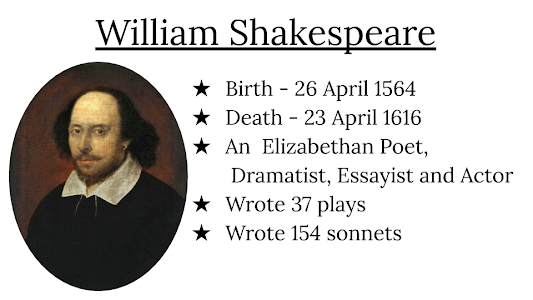Sonnet 116 by William Shakespeare
Let me not to the marriage of true minds
Admit impediments. Love is not love
Which alters when it alteration finds,
Or bends with the remover to remove.
O no! it is an ever-fixed mark
That looks on tempests and is never shaken;
It is the star to every wand'ring bark,
Whose worth's unknown, although his height be taken.
Love's not Time's fool, though rosy lips and cheeks
Within his bending sickle's compass come;
Love alters not with his brief hours and weeks,
But bears it out even to the edge of doom.
If this be error and upon me prov'd,
I never writ, nor no man ever lov'd.
INTRODUCTION -
The sonnet "Let me not to the marriage of true minds" is written by the famous poet and playwright William Shakespeare. It is also known as Sonnet 116 and is a part of the Fair Youth Sonnet Sequence. The sonnet was written likely in the 1590s but was published much later in 1609. The poem is an Elizabethan sonnet, and so its 14 lines are divided into three quatrains and one couplet. Also, the rhyme scheme of the sonnet is ABAB CDCD EFEF GG. The poem, sometimes also referred to as "True Love", explains the beauty and preciousness of love. Love is sometimes misunderstood as physical attraction and lust. The poet however clears this confusion. He considers love as an unending entity that cannot be destroyed or altered by any force.
POET -
William Shakespeare (26 April 1564 - 23 April 1616) was an Elizabethan poet, dramatist, and essayist. He is considered the greatest figure in English literature. During his lifetime, he wrote 37 plays and 154 sonnets. Even after five centuries, his works still possess their importance and popularity. His famous dramas include Hamlet, Macbeth, The Tempest, etc.
SUMMARY -
LINES 1 TO 4 -
The poet starts by saying that he is not going to accept any impediments or hurdles in the way of two lovers who are truly in love with each other. That love cannot be considered true if it changes when things get tough or get diminished by an external force. True love never changes by these but carries on and on.
LINES 5 TO 8 -
He further says that no, love is like an ever-fixed mark, like a glowing lighthouse which can never be shaken from its place however strong the winds are. It is like a star that guides ships as they wander at sea. Its value is too great to be measured, but it is still used by sailors to help them navigate. True love always leads us past all these problems towards happiness.
LINES 9 TO 14 -
The poet then adds that with time, rosy cheeks and pink lips turn dull i.e. the physical beauty of the lover diminishes. However, true love remains the same. The passing of time cannot affect it. Love doesn't change as hours or weeks go by, but continues, unchanged, until death itself comes. Hence, truer love is beyond time. At last, the poet states that if whatever he has said above could be proved wrong and if the poet's behavior could be considered as proof for it, he suggests us to think that there never has been any true love. He says that he would never write again and nor will any man ever love truly again.
THEMES -
- True Love - The poet describes the power of true love. True love rules over all forces of nature including time. It can never be altered or changed instead, it goes on with the same intensity forever. The speaker establishes this argument from the poem’s opening lines, boldly declaring that love isn't true love at all if it bends or sways in response to roadblocks.
END -
Hence, we can conclude that the speaker considers love as a powerful entity that rules over all other forces. It is the happiness that leads us away from all problems towards light and happiness. It never changes but rather continues with the same intensity from beginning to end, i.e. death. The poem is a remarkable example of Shakespeare's poetic genius and is considered as one of his best poetic works ever.











0 Comments